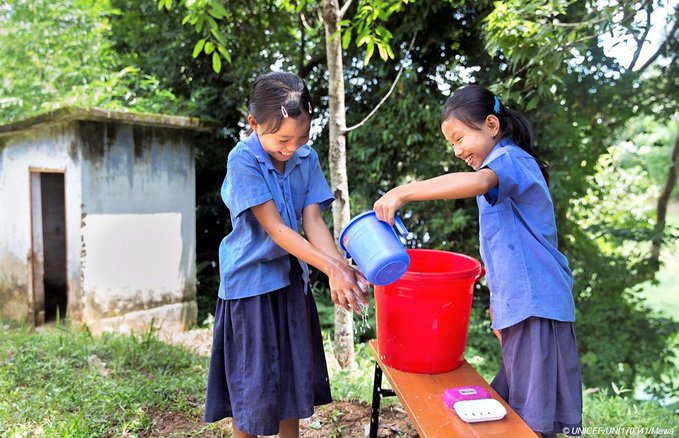Under the theme “hand hygiene for all”, global hand washing day promotes the vital importance of an equal access of water and soap for everyone everywhere to prevent diseases and save lives.
October 15 is Global Handwashing Day. A global advocacy day dedicated to increase awareness and understanding about the importance of hand washing with soap and running water. Under the theme “hand hygiene for all”, Global hand washing day promotes the vital importance of an equal access of water and soap for everyone everywhere to prevent diseases and save lives.
Proper hand washing in the time of Covid19
This pandemic provides a stark reminder washing hands thoroughly with soap is the first line of defense to prevent the spread of COVID19. However, not all of us have an equal access to water and soap to wash our hands properly. Alongside with mask, washing hands thoroughly with water and soap for at least 20 seconds can prevent COVID1( as well as wash away other common infectious diseases such as typhoid, cholera and diarrheal pathogens like rotavirus, E.Coli, and Shigella
As pandemic unfolded around the globe, hand washing stations and facilities became a critical needs for the community. But in too many part around the region, as well the world the preexisting lack of safe water, sanitation, and hygiene (WASH) resources makes hand washing impossible. In fact, at least 40% of the world’s population still don’t have access to basic hand washing facility.
While the awareness of the importance of hand hygiene in preventing the COVID-19 virus infection is high, access to hand hygiene facilities, such as water and soap is often suboptimal and out of reach, especially in the underserved, remote, low and middle income communities.
Equally distressing, WHO and UNICEF estimate that globally 3 billion people still don’t have proper hand hygiene facilities. Even more, at least 900 million children lack a place to wash their hands in school at the start of the outbreak. This situation, in return leaving them vulnerable to diseases that not only affect their health and productivity, but also have lasting health consequences.

Proper Handwashing : A “Do-it-yourself” solution
Proper handwashing with soap and water represents the first layer of defense against COVID-19 and other infectious diseases. To prevent further escalation the COVID-19 and ensure better health outcomes beyond the pandemic, hand washing with soap must be a priority now and in the true. Making hand hygiene available and accessible for all requires a multi-faceted, society-wide approach:
1. An urgent need for improvement in access to sustainable hand hygiene services (these include handwashing facilities, regular water supply, soap or alcohol based hand rub (ABHR).
2. Behaviour change interventions should address the full range of drivers to support optimal hand hygiene behaviour.
3. Components such as policy, coordination regulation financing which underpin hand hygiene services and behaviour change need to be strengthened.
“Hand Hygiene for all” – Changing hand washing behavior for good
While having access to hand washing facilities, soap and water are important step to achieve sustainable hand hygiene practice, behaviour change interventions is also needed so that hand washing becomes a long-term habit and a norm.
Here are four evidence-based recommendations for changing handwashing behavior (source : GlobalHandwashing.org):
1. Hygiene promotion is one of the most cost effective public health intervention in general and for COVID-19 prevention.
Hygiene promotion should not be taught of as a one-off event bur rather an adaptive process that gets revised and adjusted in order to support sustained change.
2. It is valuable for people to know the benefits of handwashing, how to wash their hands and the critical times it should be practices. Any education program are likely to be successful if they use multi-modal approaches, combining infrastructural improvement with ‘soft’ hygiene promotion which addresses a range of determinants.
3. Try changing the physical environment to cue and enable handwashing behavior. A study in Bangladesh showed that painting footprints on the path between the toilet and the handwashing facility increaed handwashing behavior by 64% in schools. Another study in a displacement camp found that putting toys in soap made handwashing more fun for children and made them 4 times more likely to wash their hands with soap.
4. Handwashing behaviors naturally increase during outbreaks, but work should be done to ensure sustainable behavior long term. When people are suddenly flooded with information about a new pathogen and subsequently experience fear, they perceive that they are at risk, and see social norms change to adapt to the pandemic. unfortunately, the effect of outbreaks on hygiene behavior is short-lived. The key is to learn about the priorities for local populations, enable handwashing behavior and motivate practice by positioning it as the ‘right thing to do’.
Hand Hygiene for All – beyond the COVID-19 Response
Moving forward, there needs to be coordination and commitment across governments, private sector organizations, donors, civil society, faith-based organizations, and the health care sector to rebuild better than before, strengthen our hygiene systems.
All in all, we can agree that equal access to water and soap for everyone everywhere is critical not only to prevent further escalation of the COVID-19 pandemic but also to more towards sustained hand hygiene practices. Two clean thumbs to that !
Find out more about “Hand Hygiene for All” Report and framework here
Also Read :
Find out how you can take an active role in using water efficiently without putting your health on risk here


